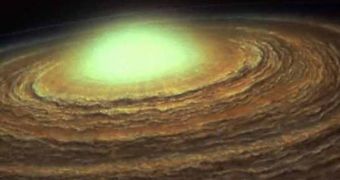In a new research paper, appearing in the latest issue of the journal Meteoritic & Planetary Science, a team of experts from the Monash University, led by Dr. Maria Lugaro, proposes a new explanation for why the chemical composition of the early solar system looks the way it does in geological records. The scientists think that the traces of radioactive nuclei, which have been identified in the earliest meteorites to hit the Earth, more than four billion years ago, may have come from a nearby dying giant star, which is estimated to have been about six times the mass of the Sun.
The new find could change our perspective on the solar system as a whole, Dr. Lugaro believes. “We have known about the early presence of these radioactive nuclei in meteorites since the 1960s, but we do not know where they originated from. The presence of the radioactive nuclei has been previously linked to a nearby supernova explosion, but we are showing now that these nuclei are more compatible with an origin from the winds coming from a large dying star,” she explains.
The conclusion of the recent investigation is based on numerous astronomical observations, using both Earth- and orbit-based telescopes, as well as on the most recent simulations employing supercomputers. The latter offered a better insight into exactly what kind of reaction occurred within a massive star, as well as what the byproducts of these reactions were, and how they spread around the celestial body.
“We need to know if the presence of radioactive nuclei in young planetary systems is a common or a special event in our galaxy because their presence affected the evolution of the first large rocks (the parent bodies of asteroids and meteorites) in the solar system. These are believed to be the source of much of earth's water, which is essential for life,” Dr. Lugaro adds.
She goes on to say that, “Within one million years of the formation of the solar system the radioactive nuclei decayed inside the rocks where they were trapped, releasing high-energy photons, which caused the rocks to heat. Since much of earth's water is believed to have originated from these first rocks, the possibility of life on earth depends on their heating history and, in turn, on the presence of radioactive nuclei.”
“What we need to do now is investigate the probability that a dying giant star could have actually been nearby our then young solar system and polluted it with radioactive nuclei. This will inform us on the place where the solar system was born, on the probability that other young planetary system[s] also are polluted with radioactive nuclei, and, eventually, on the probability of having water on terrestrial planets in other planetary systems,” the expert concludes.

 14 DAY TRIAL //
14 DAY TRIAL //